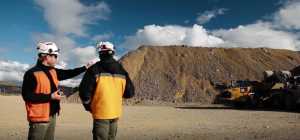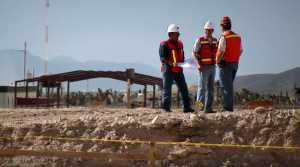Oft cited as the blow that is knocking the wind out of the services business, AI has flexed its disruptive muscle. While Uber’s advanced algorithms have produced efficiencies in ride sharing and differential pricing that have proved difficult for traditional taxi fleets to compete against, AirBnB is using advanced AI to find the perfect match between host and guest, creating an experience that will shine in comparison to high cost hotel rooms. But AI is more than a disruptive force that will displace businesses or replace workers – the technology is moving mainstream to provide decision support in an increasingly broad range of traditional sectors.
 A good example of this mainstreet extension of AI can be found in the experience of Vancouver-based Goldcorp Inc., which is using IBM’s Watson to optimize exploration. Goldcorp is one of the largest gold mining operations in the world; however, mining in general is characterized as a ‘high risk, high reward’ activity in which ore discovery can have a significant impact on profitability. Faced with growing costs for extraction and processing and increasing competition, mine operators are turning to advanced technology tools to speed the discovery of mineral deposits. For Goldcorp, these tools now include cognitive technology from IBM applied to multiple information sources to help geologists locate high-value exploration targets faster and with greater accuracy, thereby reducing extraction costs and environmental impact. Announced for the Red Lake Ontario mine in March of this year, Goldcorp’s Watson project is the first of its kind in the Canadian mining industry. But how does it work, and how does IBM believe this “exponential technology” will realize its “potential to revolutionize the future of mineral exploration”?
A good example of this mainstreet extension of AI can be found in the experience of Vancouver-based Goldcorp Inc., which is using IBM’s Watson to optimize exploration. Goldcorp is one of the largest gold mining operations in the world; however, mining in general is characterized as a ‘high risk, high reward’ activity in which ore discovery can have a significant impact on profitability. Faced with growing costs for extraction and processing and increasing competition, mine operators are turning to advanced technology tools to speed the discovery of mineral deposits. For Goldcorp, these tools now include cognitive technology from IBM applied to multiple information sources to help geologists locate high-value exploration targets faster and with greater accuracy, thereby reducing extraction costs and environmental impact. Announced for the Red Lake Ontario mine in March of this year, Goldcorp’s Watson project is the first of its kind in the Canadian mining industry. But how does it work, and how does IBM believe this “exponential technology” will realize its “potential to revolutionize the future of mineral exploration”?
While IBM has deployed its analytics platform in the oil and gas industry, moving to mining represented a new adventure. Dariusz Piotrowski, director, IBM Cognitive & Analytics Solutions Development, who provided key input to the project noted: “This is a strategic initiative for both IBM and Goldcorp. We are taking the IBM’s analytics platform tested and proven in the oil and gas industry and adapting it to the mining industry, demonstrating that cognitive subsurface analytics can lead to performance enhancement across the entire natural resources sector.” To support the cross-sectoral extension of its platform, IBM has established a Natural Resources Solution Centre in Calgary, providing space and resources to help business leaders from the petroleum and mining industries share ideas, develop proofs of concept and pilot projects. According to Mark Fawcett, partner, IBM global business services and project lead, Goldcorp’s Watson initiative was a collective effort that drew on the strengths of both the IBM and Goldcorp organizations in the implementation and training of the Watson system.

The gold in any analytics project, the Red Lake project began with the collection of information resources, including structured and unstructured data. Fawcett identified ‘unstructured’ as third-party geological articles that the team would mine with Watson to develop the right questions for Goldcorp to answer using cognitive intelligence. IBM supported this effort by helping Goldcorp to bring together ‘structured data’ – internal data sets in a variety of formats into the Watson system as a single source of analytic insight. Ranging from drilling reports to geological surveys, multiple data sources suggests integration challenge; however, as Fawcett pointed out, the majority of structured data was geospatial, mapping data on X, Y and Z planes designed to designate location. While these data sources had been used by Goldcorp in the past in isolation, IBM’s task was to pull disparate sources together in a single X and Y geological repository: the aim of embedding multiple data sources into Watson was to provide quick access to the expertise of not one, but multiple geologists, and hence deliver results on high probability sites more quickly.
The next step involved training the cognitive system. Fawcett described a couple of methods for this, including “one that we’re pretty excited about that we’re going to leverage based on what we’ve seen happen in other industries.” This approach involves partnering with universities to engage students that are in their third or fourth year of graduate studies in geological fields, or potentially undergrad or post graduates, in the teaching process. For example, IBM Canada has established a relationship with the Centre for Advanced Computing (CAC) at Queen’s University to create a Cognitive Development Hub that will allow students to develop their cognitive skills by working on real-world projects. The goal is to have university students do the actual training – establish relationships between different data variables and content context, as the foundation for machine learning – and then have professional subject matter experts i.e. the geologists, verify their results. Or to have the experts pose the questions and provide qualifiers for the information that comes back to them. According to Fawcett, IBM is now talking with a number of universities, and ultimately customers such as Goldcorp would decide which institution with which to partner.
 Fawcett described the learning process as a “journey” that will begin when sufficient content has been loaded to the Watson system to ask the initial questions: given these types of minerals and these types of parameters, where should the company look? However, with the ongoing generation of data and machine learning, he believes the system will go much further: “I think what will happen is that once we establish that [basic] level of understanding, it’s just like any educational platform or people – the questions will become more specific and deeper. I can see the potential for a whole new set of questions – for the company to look for new gold deposits where they’re not mining today…” In other words, as Watson learns, the system will build new correlations that stimulate new and more refined questions, machine learning that has potential to create deeper insight that can unleash new business value. As Fawcett explained, “I don’t think it [Watson system] will never replace the geologist who will ultimately have the right questions, but if it’s able to provide specific information, ultimately that will support making the best decision.
Fawcett described the learning process as a “journey” that will begin when sufficient content has been loaded to the Watson system to ask the initial questions: given these types of minerals and these types of parameters, where should the company look? However, with the ongoing generation of data and machine learning, he believes the system will go much further: “I think what will happen is that once we establish that [basic] level of understanding, it’s just like any educational platform or people – the questions will become more specific and deeper. I can see the potential for a whole new set of questions – for the company to look for new gold deposits where they’re not mining today…” In other words, as Watson learns, the system will build new correlations that stimulate new and more refined questions, machine learning that has potential to create deeper insight that can unleash new business value. As Fawcett explained, “I don’t think it [Watson system] will never replace the geologist who will ultimately have the right questions, but if it’s able to provide specific information, ultimately that will support making the best decision.
In terms of value, Goldcorp has already articulated the benefits of cognitive technology in mining operations. As SVP of exploration at Goldcorp Paul Harbidge noted: “Goldcorp has always been focused on responsible mining practices. By coupling our exploration and mining expertise with IBM Watson’s cognitive strength, we will be able to make the exploration targeting process more efficient, ultimately generating higher yields and creating less environmental impact. Geologists will be able to more accurately determine the next target, enabling our teams to locate undiscovered gold deposits that may have previously required multiple drills to find.”








